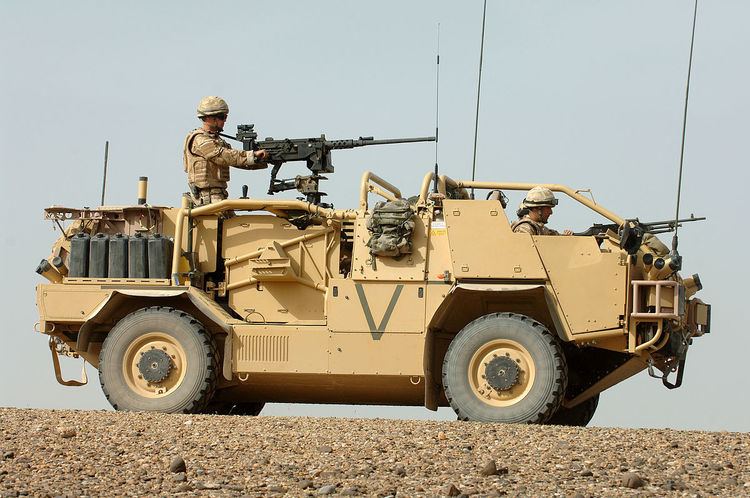Place of origin United Kingdom Weight 6,650 kg (14,660 lb) Width 2.00 m (6 ft 7 in) | Designer Supacat Length 5.39 m (17 ft 8 in) | |
 | ||
Type Armoured Wheeled Vehicle | ||
The Jackal or MWMIK (pronounced EmWimmick) or Mobility Weapon-Mounted Installation Kit is a family of vehicles designed and developed by Supacat Ltd at their factory in Honiton, Devon (UK) for use by the British Army and Royal Air Force Regiment. Supacat re-branded to SC Group in September 2015, the Supacat brand retained for the group's core defence business.
Contents
The primary role of the vehicle in the British Army is deep battlespace reconnaissance, rapid assault and fire support - roles where mobility, endurance and manoeuvrability are important - and it has also been used for convoy protection.
Small production runs are manufactured at the Honiton factory but larger batches are manufactured by Plymouth based company DML (part of Babcock Marine Services, owned by Babcock International Group). The initial order was for up to 100 and it was announced on June 27, 2008 that the MOD would be ordering a further 72. On Jun 23, 2010 it was announced by the Ministry of Defence that 140 additional Jackal 2 vehicles were being ordered, and according to the same source this would bring the number of Jackals in service up to 500.
The MWMIK can carry increased payload and fuel compared to its predecessor, allowing it to carry greater amounts of additional equipment and protection over longer distances, and it is able to support itself and its crew for distances of over 497 mi (800 km).
Design and development
According to the Ministry of Defence, the Jackal "was built to meet the British Army's specific requirements for an agile, well-armed, light patrol vehicle." The vehicle's height-adjustable air suspension system can be lowered onto the bump-stops to provide a stable firing platform when stationary or raised to a maximum 380mm ground clearance allowing it to clear large obstacles. The high levels of off-road mobility enable troops to avoid more conventional routes which may be subject to ambush or enemy reconnaissance.
The vehicle is based on the HMT (High Mobility Transporter) 400 high-mobility 4×4 design developed by a former subsidiary of Supacat, now built under licence from Lockheed Martin. The chassis is built by Universal Engineering Ltd, the engine by Cummins, the transmission by Allison, the suspension shock absorbers by Fox Racing Shox and the electronics package by Fujitsu and Smartgauge Electronics. The blast and ballistic armour packages, and the blast mitigating seating were designed and built by Jankel Armouring Ltd. The vehicles can be fitted with a range of weapons, such as a 12.7 mm Heavy Machine Gun, 7.62 mm General Purpose Machine Gun (GPMG) and 40 mm Automatic Grenade Launcher.
The Jackal is capable of maintaining off-road speeds of up to 49 mph (79 km/h) and can reach a top speed of 80 mph (130 km/h).
Afghanistan deployment
The vehicle was procured to provide British forces in Afghanistan with an off-road patrol and fire-support vehicle with increased performance, supplementing the Land Rover Wolf WMIK and the Snatch Land Rover which previously fulfilled the role. In particular the Snatch Land Rover, although able to withstand small arms fire, is vulnerable to improvised explosive devices and was labelled by some a "mobile coffin". On 8 April 2008, it was announced that the MWMIK had been deployed to Helmand Province, Afghanistan, as the Jackal 4x4 Patrol Vehicle.
The Ministry of Defence has stated that the design of the vehicle hull incorporates the latest armour protection and that it is considered to be among the best in the world. The HMT 400 mine blast and ballistic protection system was developed for Supacat by Jankel Armouring Ltd. It features armour plating beneath the crew compartment and on the vehicle sides, as well as attenuating seats that absorb shock from any mine blast. The top of the cabin is left open for visibility, which affords the vehicle protection through its manoeuvrability and main armament stand-off distance. These enable it to avoid exposure to riskier IED prone routes. Despite this Jackal crews have suffered a number of IED attacks, some fatal.
Jackal 2
An updated version of the Jackal has been ordered as Jackal 2. The crew has been increased to four and the main armament gun ring moved forward to give it an all round arc of fire. The chassis has been upgraded, allowing the vehicle to carry a greater payload and armour, and providing more strength for protection against roadside bombs. It also has a larger 6.7 l engine, although this does not increase the speed of the vehicle. An initial order for "around 110" vehicles was made in 2009, with final deliveries in February 2010. A further order for 140 of the Jackal 2A was announced on 23 June 2010, which is based on the Jackal 2 platform with a blast protection upgrade.
Coyote
Coyote Tactical Support Vehicles are a larger 6x6 design with more than 70 ordered as medium load carriers, artillery tractors and a range of other platform variants.
The Coyote tactical support vehicle (TSV light) is based on the HMT 600 6×6 chassis from Supacat and is a larger derivative of the Jackal 2, the two vehicles are designed to be complementary. The extra two wheels give a heavier vehicle approaching 10,500 kg (10.3 long tons) which will act in support of the Jackal 2 and allow transportation of supplies and equipment over similar terrain (the payload for supplies and equipment will be 3,900 kg (3.8 long tons)). The Coyote has been designed to fulfil the role of a light tactical service vehicle.
